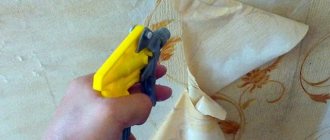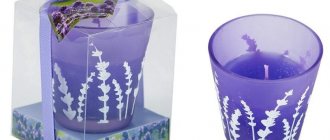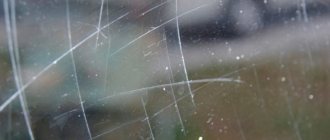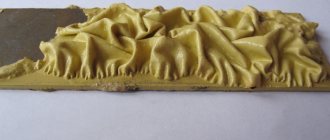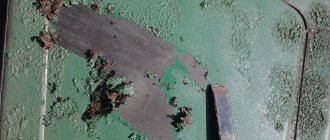05 November 2019
A popular finishing material is paint, which reliably protects the surface of plastic and wood for a long time. But over time, the appearance is lost and a rhetorical question arises: how to remove old paint from the walls. Moreover, those who have tried to do this mechanically know that the bathtub coating can be ruined. Also, during the construction or renovation of a residential premises, window sills, sockets, walls, switches, etc. may be damaged by paint and varnish materials. The “paint” problem can be solved if you know the characteristics of the surface and the composition of the substance. The common thermal method is also not an option for plastic, since the product may “lead.” It remains to turn to the chemical method.
Mechanical cleaning
This method is quite suitable for use at home: it does not require complex equipment or special skills. To clean the glass you will need:
- hot water;
- dishwashing liquid;
- a piece of clean cloth;
- blade or sharpened thin knife.
You can use a stationery knife, as well as a special scraper of the required size. If you don’t have anything at hand, then a hard metal dishwasher will do.
To begin, dissolve the detergent in a container of hot water and moisten the old paint on the glass with this solution. To prevent moisture from getting on freshly painted wooden window sills, they must be covered with film.
Scraping paint should be done at an optimal angle of 45 degrees. This will avoid the formation of cracks and scratches.
Removing drops of paint from glass is done with gentle movements and in one direction, periodically removing dirt from the blade. If the drop is wet enough, the stain will come off easily. Do not constantly move the tool from side to side - this will easily scratch the window glass.
The sound that the blade should make cannot be anything like grinding or squeaking. This may indicate a dull tool. In this case, it should be changed.
After the plastic window has been completely cleared of paint, they begin to wash the glass using a special product with a spray bottle.
How to remove oil paint from walls - step by step diagram
Step 1: Apply wash
The remover should be applied with a brush or roller, working in one direction, without repeated applications to the same section of the wall. Try not to splash the remover, avoid contact with the skin. If this happens, rinse with warm water.
Step 2: The wash works
You won’t have to wait long - some solvents can do the job in a matter of minutes, as evidenced by characteristic visible reactions.
Step 3: Clean with a spatula
The paint softens and can be easily removed with a spatula or a metal brush. True, the wash does not always cope with all layers at once - in this case the process has to be repeated.
Step 4: Neutralize the remover
If possible (so as not to flood your neighbors), try to wash off the remaining chemicals from the wall - such an aggressive composition should not be left on the surface.
There are also more gentle, and most importantly, less expensive ways to get rid of paint using chemicals. For example, if we are talking about removing such a coating from a plank surface, you can get by with water and soda ash. We wet the surface generously, cover it with a decent layer of soda, cover it with damp burlap or any other rough cloth and wait a day, periodically wetting the cloth. With a spatula, paint swollen from dampness can be cleaned off easily and simply.
Scraping paintwork
If there is a need to renew wooden frames, then it is worth preparing the surfaces before painting. The wood needs to be cleaned so that it is smooth, without any pieces of peeling paint. Then the new window covering will not come off after a short time.
The most common construction tool used for these purposes is a spatula.
Sometimes a metal sponge is used for dishes. It allows you to clean the window surfaces upon completion of the main work.
When wood frames are first painted, it is likely that the factory finish was polyurethane paint. In this case, before cleaning, the frames are wiped with soapy water and treated with sandpaper. Next, you can apply a special primer to make the paint stick better to the window.
A rather interesting method is to burn old paint from the window frame. Using a special cylinder, the coating layer is heated with a flame. Next, the wooden frames are cleaned with a spatula, and the remaining irregularities are removed with coarse sandpaper. Before painting, cracks in the wood are puttied and cleaned using a sanding machine.
Features of washing PVC windows
Cleaning plastic windows after renovation in a new building cannot be done in a hurry, rushing to finish the process as quickly as possible. Although the procedure is much faster and simpler than washing wooden frames, it is still important to follow certain rules.
There are several recommendations that allow you to properly clean your window without scratches, cracks, stains, or streaks:
- Before work, you need to take a soft, lint-free cloth, which often remains on the surface during washing. You will also need microfiber cloths and newspapers to clean windows.
- At the first stage, it is important to clean the outside of the window, then the inside. After washing the glass surface, proceed to washing the frame, fittings and only then the window sill.
- You should plan your work on a cloudy day, in the morning or evening.
- It is prohibited to use alkalis or abrasive powders.
- When using solvents, do not forget about protective equipment (goggles, gloves, mask).
Attention! Before washing windows, sweep away dust and debris with a rag or vacuum cleaner.
Cleaning with chemicals
The chemical method of cleaning plastic windows has a number of advantages:
- ease of use;
- achieving high results;
- Possibility of removing stubborn or stubborn stains.
The main means of this method is the so-called wash. It can be purchased at any hardware store. You can familiarize yourself with the use of such a chemical on the label, but the principle of use is almost the same:
- Before removing the old paint from the window, it is worth carrying out preparatory work: clean the glass surfaces from visible dirt and dust.
- A remover is applied to the paint stains. The solution must remain on the dirt for some time so that the coating can swell.
- After curing, remove the peeling paint from the glass with a construction spatula or scraper and wipe the surface with a solvent.
- Finally, the plastic windows are washed with a solution prepared using water and vinegar.
The most convenient form of removing old paint is a paste - it does not run off the glass.
Technology and consistency
Removing old paint from the plastic surface of a window, door or other element in a home interior is done as follows.
Immersion in solution
The easiest way to remove paint is from polystyrene. Washing is performed as follows. The panel from which the coating needs to be removed is immersed in a 20% solution of caustic potassium or soda (a 50% aqueous solution of caustic soda can also be used). For greater clarity, it is better to wash in a glass container.
After 4-5 hours, any paint (including acrylic, rubber or oil) will begin to bubble and move away from the surface of the plastic. To completely remove the previous coating, it is best to use an old toothbrush with increased rigidity.
For small surface areas of a window or door that need to be washed, you can use any solvent - solvent, acetone or white spirit. The easiest type to wash off is ABC grade plastics.
Compositions such as brake fluid and water-soluble compounds for cleaning sewer pipes such as “Mole” are quite effective for removing old paint from plastic.
Although their washing mechanism is different - brake fluid separates the coating layer by layer, and “Mole” simply dissolves the paint - the final effect turns out to be quite comparable.
After applying the chemical composition with a cotton swab or glass rod dipped in warm water, you should carefully wash off the remaining layers and areas of paint that have separated from the plastic.
Actively removes all types of paint from plastic plates - from water-based to alkyd enamel - methanol. However, the use of such a composition differs in two features:
- Methanol is toxic.
- After using it, clean the surface of the window, door, etc. It is necessary to rinse immediately with warm water, since traces of oil remain on it, and the cleaned product itself may turn yellow over time.
Homemade solutions
There is not always available cash to purchase special chemicals for cleaning paint. Ingenuity and skillful hands will come to the rescue. Homemade solution consists of:
- caustic soda;
- slaked lime;
- crushed chalk
First, mix lime and chalk until smooth, and then add soda. The ideal consistency should look like thick sour cream.
Apply the prepared paste to the stains and leave the mixture for several hours. After the specified time has passed, you can easily remove the dirt with a spatula. The method is considered inexpensive compared to thermal and chemical ones.
What to do with the window after the paint is removed?
After the old paint is removed, we restore the handles, fill the gaps, sand them, apply an antifungal agent, prime them, paint them, and glue a sealant for better thermal insulation. As a painting medium, you can use acrylic varnish (applied in one layer), which is applied to an acrylic primer. This primer contains an antiseptic, so there is no need to use anti-fungal agents.
By properly cleaning the frames thoroughly and applying a good quality primer and paint, you can have aesthetically pleasing windows for five years or more.
Thermal method
This method is usually used if:
- The stains are quite old.
- Window stains have become very dry or difficult to remove.
- The surface to be cleaned is large.
- The paint layer is quite thick.
The tool used for this method is a regular hair dryer. But if you don’t have such a device, you can use an iron.
Naturally, before using high temperatures, the glass must be cleaned and degreased.
A heat gun is brought at a slight angle to the surface of the stain and waited until bubbles form. After this, the paint that has peeled off the windows is carefully removed with a spatula.
If you use a regular iron, then place a piece of foil on the stain and only then begin to heat the stain with an electric device.
Getting rid of traces of plaster
After the window is installed, all cracks around the opening are sealed. As a result of such work, drops of plaster fall on the plastic. If you notice this right away, the stain can be easily removed with a damp cloth. But if the plaster has already dried, you will have to tinker a little. It is convenient to clean the mixture with a spatula wrapped in a rag - this way you will not scratch the plastic surface with sharp edges. Trim the dried plaster as close to the base as possible, and clean the remains with a stiff brush.
Useful tips
To achieve maximum efficiency when removing paint from plastic windows, you should use some rules:
- Before painting, lubricate surfaces on which you do not want paint to come in contact with a thick layer of laundry soap - this will make it much easier to wash away stains.
- When heating the paintwork, the main thing is not to overdo it, because the glass can crack.
- Before using washing solutions, it is necessary to ensure good air circulation: the pungent odor must dissipate during operation.
- Old acrylic-based paint can be easily removed with alcohol, and enamel is dissolved with acetone-containing substances.
The presented methods are quite effective in application. The main thing is to remember that the result depends on the correct use of the tool or chemical.
Causes of leaks
There may be one reason, or maybe several at the same time. When painting any surface, the following factors should be avoided:
The thicker the coating, the harder it is to spread over the wall or ceiling.
Before starting painting work, the paint must be sufficiently diluted, this is most important for the very first layer. Manufacturers of paints and varnishes often indicate on the cans that the paint is ready for use or that it can be diluted no more than 10%. However, any coating needs to be thinned
Water-based paints are thinned with water, while oil-based paints and enamels are thinned with a solvent. The amount of liquid may exceed 10% of the paint volume, but at the same time you should not add more than 20%. After dilution and thorough stirring, you need to check the thickness of the coating. Dip the roller into the paint and lift it up. If the paint flows off it slowly (it flows, not flops), then the viscosity is normal. You need to apply and roll the paint over the surface quickly, without interruption. Otherwise, the painted areas will dry before you roll the boundaries between them. And after complete drying, the walls will become striped. It is best to paint a smooth surface with a short-haired roller. Using a long-haired roller is advisable only if you are working with a textured coating. In all other cases, such a roller will certainly “decorate” the ceiling and walls with smudges. The problem of poorly painted areas occurs when there is insufficient lighting or poor vision of the painter. On a wet surface it can be difficult to see areas that have not been completely painted. Therefore, you need to take care of a bright, but not blinding lamp, or don’t be shy about wearing glasses. If you apply paint to a plane in stripes, their boundaries become very clearly visible after drying. The coating should be applied in a W-shaped motion, which will be discussed in more detail below. A poorly puttied, sanded, or cleaned surface after painting will certainly expose the defects to everyone. Hoping that paint will hide some imperfections is deeply mistaken. On the contrary, she will show them “in all their glory.”
Reasons for the appearance of smudges and drops on the coating
First, let’s better understand the question of what are the main reasons for the appearance of these defects; this is necessary primarily for those who have not yet started work.
The list of factors is quite lengthy:
- low quality paints and varnishes.
- an incorrectly selected solvent or failure to comply with the proportion of paint dilution, which makes it too liquid and does not adhere well to the surface.
- incorrect settings of the spray gun and compressor, or applying the material at the wrong angle, and often the tool is moved too far from the surface. Here you need to follow the application technique.
- ingress of dust and insects.
- lack of temperature control, which at low temperatures leads to slow setting of the material and the formation of drops and smudges on the surface of the car body.
- failure to adhere to the drying regime between layers.
- lack of experience to apply a uniform layer of material.
These are basic things, and most of the nuances can be eliminated if you first try to apply the material to a test surface, set up the tool correctly and fine-tune the operating technique
Also pay special attention to the preparation of the workspace, this applies to cleanliness and temperature in the room
Protective film
Some owners neglect the instructions and do not remove the protective tape, explaining that the repair is not yet completed and the plastic profile needs to be protected from stains and construction dust. This is of course true, but over time the glue changes its properties and the film tightly “sticks” to the frame. It’s better to remove it immediately and stick on masking tape, which can be easily removed and protects it from dirt just as well.
If you didn’t know this, and the film has managed to stick tightly, then use one of the suggested means:
- Construction hair dryer and scraper for metal-ceramic plates. It is necessary to heat the film and remove it with a scraper for cleaning metal-ceramic stoves.
- Scrape off pieces of film with a blade or a stationery knife, and erase the remains with an eraser. It will take quite a long time to clean, but the result will not disappoint you.
- If the film has crumbled, then washing it can be quite difficult. White spirit or technical alcohol will be useful for this work Apply the product to the pieces of film, wait a few minutes and scrub thoroughly with a brush with stiff bristles (do not use a metal one!)
- Another way to remove small pieces is to stick wide tape over it, press it well, smooth it out, wait an hour and tear it off along with the stuck pieces of film.
For detailed instructions on how to remove the remaining protective film from a plastic profile, please follow the link.
Sometimes such an unpleasant situation happens: the film is removed, and inscriptions, sticky traces of glue and paint are imprinted on the frame. Over time, dust will settle on the glue, and the windows will look absolutely terrible. What to do in this situation?
First, try to wash off the glue stains with water with the addition of dish soap, soap or washing powder, and rub thoroughly with the hard side of the sponge. If traces remain, then you will have to go to a hardware store and buy a special composition for removing glue: Mellerud, SOLINS, Antiscotch, and the like.
Use the products strictly according to the instructions, wear protective gloves. Before applying it to the entire window, try it in an inconspicuous place; if the plastic has not changed color and its gloss has not faded, then you can apply it to the front part of the frame.
If the letters are printed and cannot be washed off with soapy water, alcohol, or chlorine bleach, you will have to use Cosmofen 20 plastic solvent, which can be purchased at a hardware store or at the company where you ordered the windows.
Be careful: Cosmofen 5, 10 and 20 are on sale; the lower the number, the stronger the solvent. For example: No. 5 dissolves plastic too much; it is used to remove deep scratches, but more on that below.
In our case, we need twenty - in its properties it is more similar to plastic polish. You need to apply a little product to a soft white cloth (make sure that the rag does not leave lint) and rub lightly to remove traces of paint. Finally, gently polish the area using circular motions.
You might be interested in learning how to whiten yellowed plastic windows.
Attention! Use " Cosmofen " and similar products from other brands only as a last resort, if household chemicals are powerless. Some types of plastic may change color when exposed to solvents or lose their gloss.
Use of solvents
The easiest way to remove traces of paint from window glass is to use solvents.
| Pros of using solvents | Disadvantages of using solvents |
| · high efficiency; | · additional financial costs for the purchase of solvents; |
| · speed; | · When working, it is necessary to observe safety precautions. |
| · safety for glass surfaces. |
The choice of solvent depends on the type of paint.
For oil paints use:
- Petrol. Widely used solvent. To clean glass, you should purchase purified gasoline, for example for lighters. Refined kerosene will have a similar effect.
- Turpentine. A substance of complex composition, suitable for removing traces of not only oil-based paints, but also alkyd-styrene paints.
- White Spirit. The solvent is used to dissolve oil and enamel paints.
For other types of paints the following solvents are needed:
- Acetone. Suitable for removing traces of perchlorovinyl paints.
- Solvent No. 646. Cleans acrylic paints and epoxy varnishes well.
- Solvent No. 647. It will help wash off nitro enamel from glass.
When using solvents, you need to make sure that these liquids do not get on the plastic parts of the frames and window sills. Acetone is especially dangerous in this regard: it can seriously damage plastic. Therefore, it is worth covering the window sill in advance with several layers of newspapers or film. Such a protective measure will be sufficient.
If the marks on the window are old, then it is not easy to determine the type of paint from them. In this case, it is recommended to use a universal paint remover. Another almost universal substance that dissolves most paints is toluene. But it belongs to the toxic category, so it requires caution when used.
Stains and stains on the ceiling after painting: how to fix?
So, we figured out the reasons. In the future, this will help us not repeat mistakes. But what to do now, when the ceiling is already painted, and there are terrible stripes, stains, and smudges on it? How to bring it to mind?
The only sure way is to sand (sand) the entire ceiling until the surface becomes uniform and rough. Don’t worry, there won’t be a lot of dust and dirt, because only a layer of paint is removed. The skin should be relatively fine. You need to work quite carefully so as not to touch the putty layer.
Then you need to wipe the ceiling with a damp cloth and inspect the surface in bright daylight. If the ceiling has become smooth and uniform, you can start priming. If the surface does not inspire confidence, you should use finishing putty, applying it in a thin layer. After drying, light sanding again.
The next stage is priming
It is important to buy a quality primer for painting. It is better to prime several times - at least twice
Each time you need to let the surface dry completely.
When the ceiling looks perfectly even and smooth, like a mirror, you can begin painting.
Remember: if the base has streaks, spots and unevenness, all this will be noticeable even after painting! Therefore, before you take up the roller and paint, make sure that the ceiling is in perfect order. If in doubt, prime again.
How to deal with stains from old leaks on the ceiling? These areas require special treatment. First you need to thoroughly clean and wash them, wait until dry. Then treat with a biocidal solution (for example, Fongimur). Do not wash off the product! After this, use a universal blocking primer. It blocks stains from appearing through putty and paint.
Recommendations from experts
When starting to remove paint from the glass surface, you need to consider the following points:
- It is easier to remove a fresh paint layer than an old one.
When working with solvents, it is necessary to ensure good ventilation in the room and use rubber gloves, a respirator, and special goggles for protection.- Before using a solvent, you need to study the instructions for the product and make sure that it is intended for removing a specific type of paint.
- In order to reduce the likelihood of paint getting on the glass, it is advisable to protect the window before painting. For example, smearing it with a thick soap solution. In the future, accidentally spilled paint will be easy to wash off.
- You cannot mix several types of solvents in one area.
If it is possible to position the glass horizontally when cleaning, it will be more convenient to work with it.
How to choose what is best to clean a window?
The choice of method is determined by:
- the extent of the affected surface;
- how old the blots and drips are.
For fresh stains, simply using a damp cloth will solve the problem. And you will have to tinker with old traces of staining using the above methods.
For small stains, a mechanical method is suitable to remove splashes from the surface . In case of significant staining of glass with paint, chemical and thermal methods are suitable. High temperature treatment can also be used for old multi-layer stains.
When exposed to chemical reagents, it is necessary to strictly follow safety precautions and prevent solvents from getting on the frame and window sill. When working with windows, the use of solvents in a spray is undesirable, since it is difficult to control the coverage area.
Very often it is necessary to use several methods , combining them to obtain the best result.
Possible methods
Glass is a fragile material, but hard and chemically inert. Therefore, in order to wash paint off glass, you can use different methods:
- The simplest one is mechanical. Since glass is usually scratch-resistant, it can be rubbed with hard sponges or even scraped with a knife.
- Sometimes, to facilitate the process of mechanical removal of smears and drops, preheating is used. But here you need to be careful: a sharp temperature change can cause the glass to burst.
- The chemical method is less labor-intensive. Glass can be treated with various solvents; it will not cause any harm.
Whitewash
Dry whitewash on glass and plastic can be easily wiped off with a dry rag; using a wet rag will only spread the dirt and will take a long time to wash away stains and drips. After you have removed most of the whitewash with a dry cloth, you can start cleaning the window. The plastic profile is washed with soapy water, and the glass is washed with window cleaner or homemade detergent (for 2 liters of water, 1 tablespoon of ammonia or 2 tablespoons of vinegar).
Things are not so good with lime whitewash; it won’t go away that easily. It can be removed from glass with a blade or a stationery knife. In order to wash off lime from PVC windows, use one of the suggested means:
- Cillit , dilute with water one to one and apply to the stained surface, after a few minutes scrub with a hard washcloth. Be careful, Cillit contains oxalic acid, test in a hidden place before use.
- Dissolve a tablespoon of vinegar or citric acid in a bucket of water and wash the profile.
- Table salt also helps get rid of lime. A glass of salt on a bucket of water.
- Instead of salt and vinegar, you can add vegetable oil to the water: 100 g. for 10 l. water, the same composition is used to wash dirty floors, vinyl wallpaper and even wooden furniture. After the whitewash has been washed, the surfaces are degreased with dishwashing liquid. Lacquered furniture is not degreased, but polished with a soft cloth.
Wallpaper glue is easily washed off with warm water.

